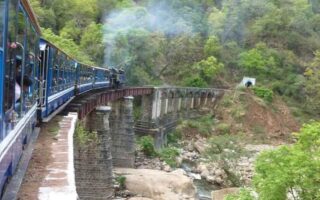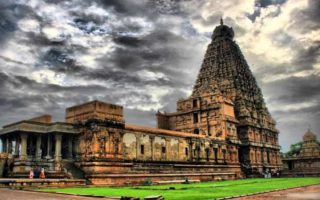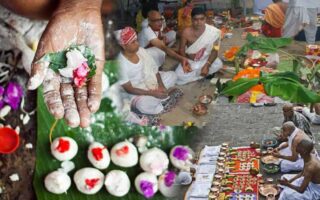“Satyam Shivam Sundaram” is not just a group of three words but a truth that Lord Shiva is the beauty incarnate. Lord Shiva annihilates the creation when it reaches the apex of decadence. Associated with no feeling of fear or death, he is the ‘Nataraj’, the cosmic dancer, who destroys the evil, saves righteous, and makes his devotee ‘Mrityunjay’, a winner over death. With 1008 names and worshiped in the form of lingam; he is also omnipresent and Yogi of Mount Kailash. Mahadev Shiva is a part of the Trinity (Brahma, Vishnu, and Mahesh) and his temples are found in every nook and corner of India. Among them, some are ancient Shiva temples. Almost every Hindu is a worshipper of Lord Shiva. To visit the most famous Mahadev Shiva temples, all Hindu pilgrims should visit the following famous pilgrimage circuits at least once.
- 12 jyotirlinga temples
- Amarnath temple yatra
- Panch Kedar (5 temples)
- Pancha Bhoota Sthalams (5 great elements)
Chardham yatra, Kanwar Yatra, Maha Shivratri, and Jalabhishek to Lord Shiva in Shravan (July) are also deeply associated with lord Shiva. The following article will offer a long list of famous and well-known temples dedicated to Lord Shiva in all parts of the world.
Jyotirlings Temples in India
Twelve in number, all jyotirlingas are dedicated to Lord Shiva, the Supreme rescuer of innocents. These jyotirlingas are considered as the most revered temples dedicated to Lord Shiva in India. Visiting these temples make devotees free from all sins of the world. Let’s have a look at these 12 sacred temples that take devotees to the abode of almighty.
Somnath Temple
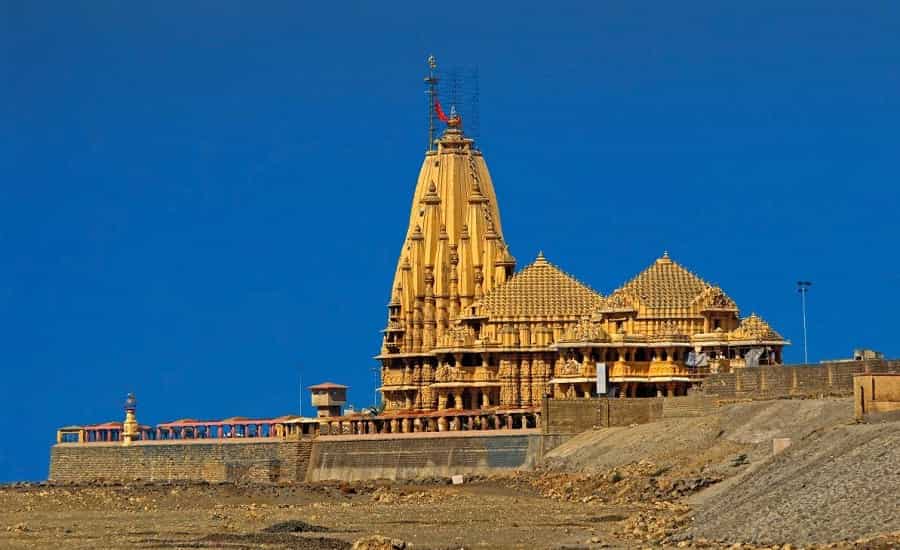
Somnath or Pattan Somnath is one of the 12 Jyotirlinga temples dedicated to Lord Shiva and was built by the Moon God for the purpose of getting rid of Daksha’s curse. The temple is believed to have been renovated by the Ravana, Shri Krishna, and Bhima. The temple has been ruined and looted by foreign invaders many times. An Arrow Pillar, known as Baan Stambh, is the prime attraction of the temple and Hindus should visit this temple before they die. Last time, it was reconstructed after 1947 by Vallabhbhai Patel, the first Home Minister of India. Panch Pandava Gufa is also a famous attraction of this city.
- Location: Prabhas Patan, near Veraval, Gujarat
- Nearby religious places: Suraj Mandir, Parshuram Temple, Lakshminarayana Temple, Gita Mandir
- Best season to visit the temple: Winter (October-March)
- How to reach: Keshod Airport, Keshod (47 km); Veraval railway station (7 Km) from Somnath; Regular bus services from all districts of Gujarat
- Accommodation: Budget, standard, deluxe, and luxury hotels, resorts, inns, and traveler stays in Veraval.
[Also Read: Must-Visit Hindu Temples in Gujarat]
Mallikarjuna Swamy Temple
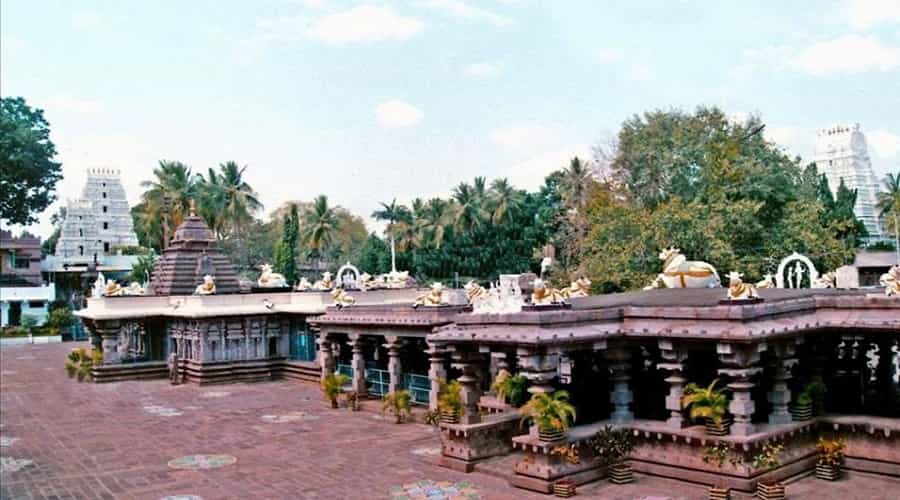
Popular as ‘Kailash of the South’, it is another holy and most popular Jyotirlinga shrine situated on the bank of the River Krishna. The temple looks outstanding with its great architecture.
Mallikarjuna Swami Temple built with Chalukya architecture, was built by King Harihara Raya of Vijayanagar in 6 century. This temple has a famous tale associated with Lord Ganesha and Kartikeya. This temple is believed to emancipate pilgrims from all sins and get out of the fierce cycle of life and death.
- Location: Srisailam, the Kurnool district of Andhra Pradesh
- Nearby religious places: Bhramaramba Devi temple
- Best season to visit the temple: Winter (October-March)
- How to reach: Hyderabad airport; Kurnool railway station (97 Km) from Somnath; and regular bus services
- Accommodation: Budget, standard, deluxe, and luxury hotels, resorts, and inns Srisailam.
Mahakaleshwar Mahakal Temple
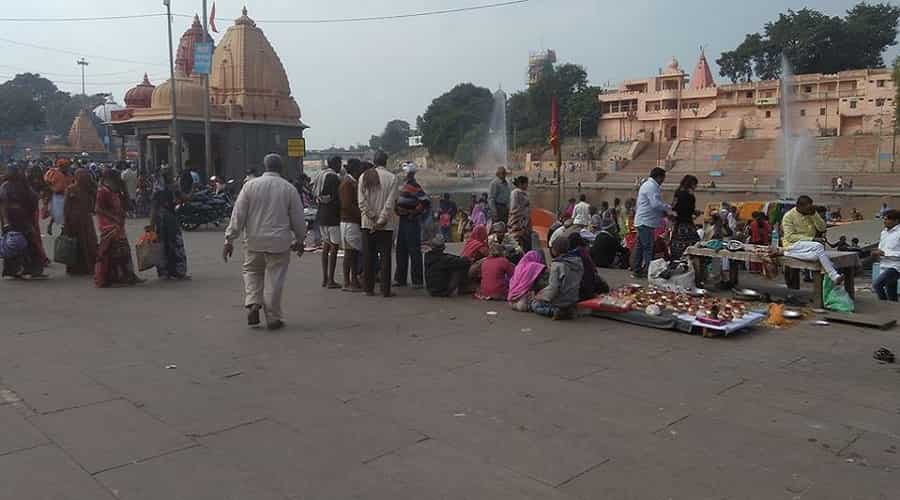
The deity of this one of the 12 jyotirlinga temples is Mahakal who is also the Lord of the death of all three Lokas: heaven, earth, and Hades. This temple is a sacred spot of Hindu divinity for millions of pilgrims and also an ideal destination for Nirvana seekers, experience seekers, God lovers, and spiritual seekers. Swayambhu Lingam or Dakshinamurti is the presiding deity of the temple. The prime attraction of the temple is the Bhasma Aarti. Come to this place to seek blessings of Lord Shiva and visit a must see religious site for all Shiva devotees.
- Location: Ujjain, Madhya Pradesh
- Nearby religious places: Bade Ganeshji ka Mandir
- Best season to visit the temple: Winter (October-March)
- How to reach: Devi Ahilyabai Holkar Airport, Indore (50 km); Ujjain railway station; regular buses from Delhi, Jaipur, Pune, Mumbai, Ahmadabad
- Accommodation: Budget, standard, deluxe, and luxury hotels, resorts, and inns in Ujjain.
Omkareshwar Temple
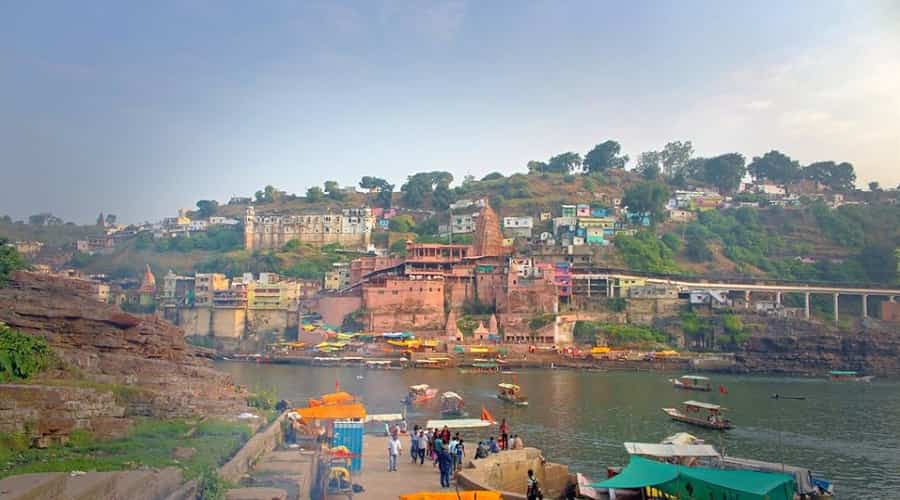
Near the confluence of Narmada and Kaveri, Omkareshwar Temple is one of the 12 jyotirlinga temples. It is a 5-storied building that looks like “OM” shape. Tourists and devotees from all over India and rest of the world flock to this temple to pay respect to Hindu Lord Shiva. Built in Northern Indian style of architecture, this temple is considered a highly sacred place by the Hindus as Lord Shiva emerged here in the Jyotirlinga form to defeat the Danava.
- Location: Indore, Madhya Pradesh
- Nearby religious places: Siddhnath Temple, Satmatrika Temples, and Kajal Rani Cave
- Best season to visit the temple: Winter (October-March)
- How to reach: Devi Ahilyabai Holkar Airport (77 km), Indore; Indore railway station; regular buses from Delhi, Pune, Mumbai, Shirdi, Bhopal, and Dhule
- Accommodation: Budget, standard, deluxe, and luxury hotels, resorts, and inns in Indore.
Kedarnath Temple
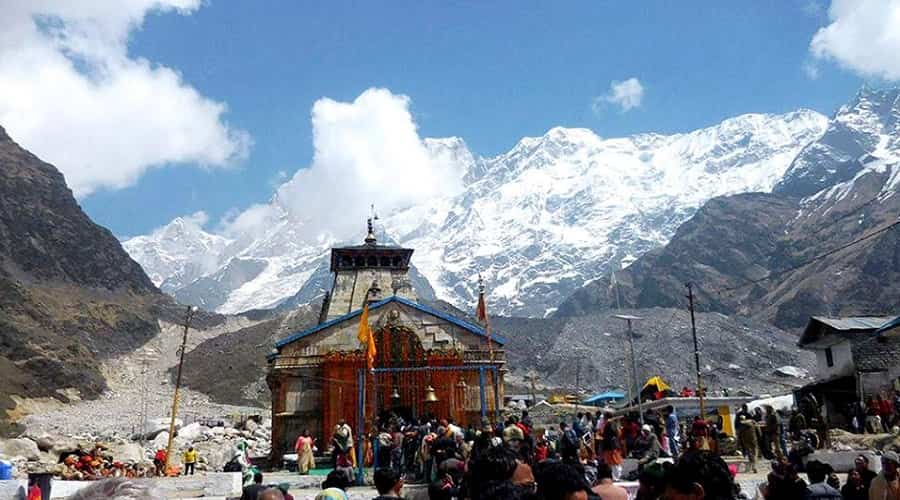
One of the twelve holiest Hindu shrines of Lord Shiva Kedarnath is a popular destination not only for Hindu pilgrims but also for tourists. This holy temple was constructed by the Pandavas where the presiding deity is Kedarnath, the ‘Lord of Kedar Khand’. It is one of the greatest Shaivite shrines in India that was in news in 2013 for a natural disaster caused by a sudden melting of iceberg, floods, and landslide. In the greatest tragedy, around 5700 people were dead. This temple is also one of the four destinations of Chardham Yatra of Uttarakhand. It is also one of the five temples comprising the Panch Kedar.
- Location: Kedarnath, Uttarakhand
- Nearby places: Chandrashila and Son Prayag
- Best season to visit the temple: Winter (October-March)
- How to reach: Jolly Grant airport (239 km), Indore; Rishikesh railway station (221 km)
- Accommodation: Budget, standard, deluxe, and luxury hotels, resorts, and inns in Kedarnath.
Bhimashankar Temple
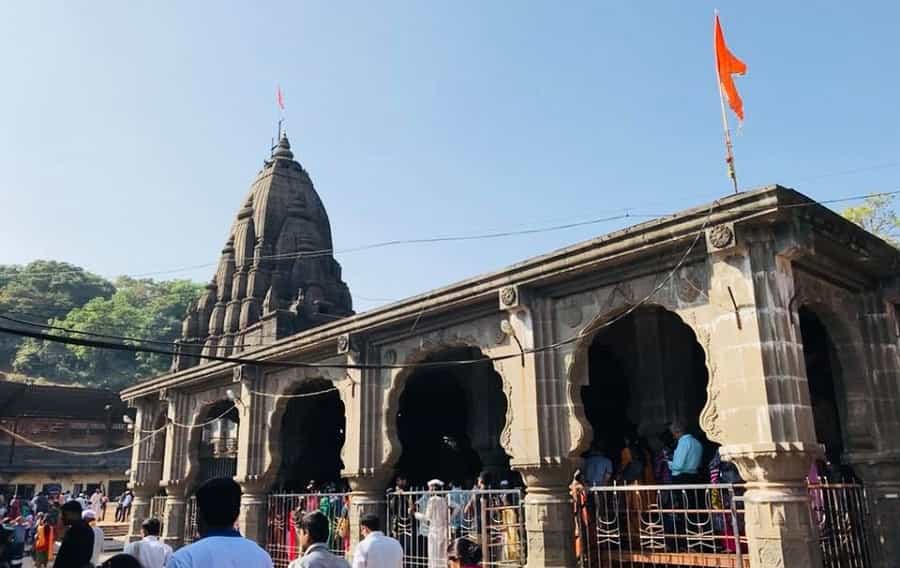
Bhimashankar is a revered religious site for millions of Hindus as it is the place where Lord Shiva incarnated in the form of Ardhanarishwara to kill demon Tripurasur. According to archaeologists of India, the temple was made in the 13th century. Its extension “Sabhamandap” was made in the 18th century. It is likely that one may experience heavy rainfall during the same season. There is another mythological story associated with the Kumbhakarna’s son Bhima and this temple. Come to this place to take the blessing of lord Shiva.
- Location: Pune, Maharashtra
- Nearby places: Sahyadri wildlife sanctuary
- Best season to visit the temple: September-January
- How to reach: Pune airport; Pune Railway Station (111 Km)
- Accommodation: Budget, standard, deluxe, and luxury hotels in Pune.
Kashi Vishwanath Temple
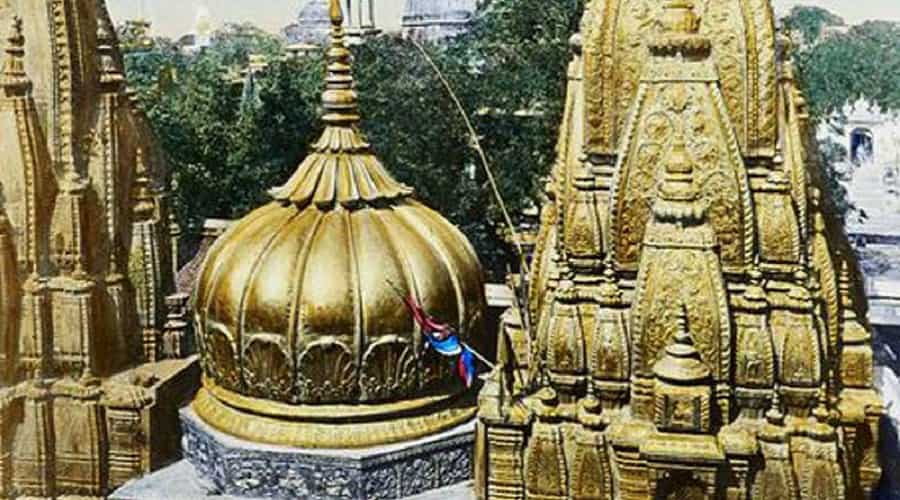
Come to this place if you want to get real freedom from the vicious cycle of rebirth. It is said that one who takes breathes his last here reaches heavenly abode. This holy temple is one of the most popular pilgrim destinations in India among the twelve Jyotirlingas and is believed that is it also dearest to Lord Shiva. Mughal king Aurangzeb had destroyed this temple, but it was reconstructed in 1780 by Maratha monarch, Ahilya Bai Holkar.
- Location: Varanasi, Uttar Pradesh
- Nearby temples: Bharat Mata Mandir, Thai temple
- Best season to visit the temple: Oct-March
- How to reach: Varanasi airport; Varanasi railway station and Kashi railway station
- Accommodation: Budget, standard, deluxe, and luxury hotels in Varanasi.
Trimbakeshwar Shiva Temple
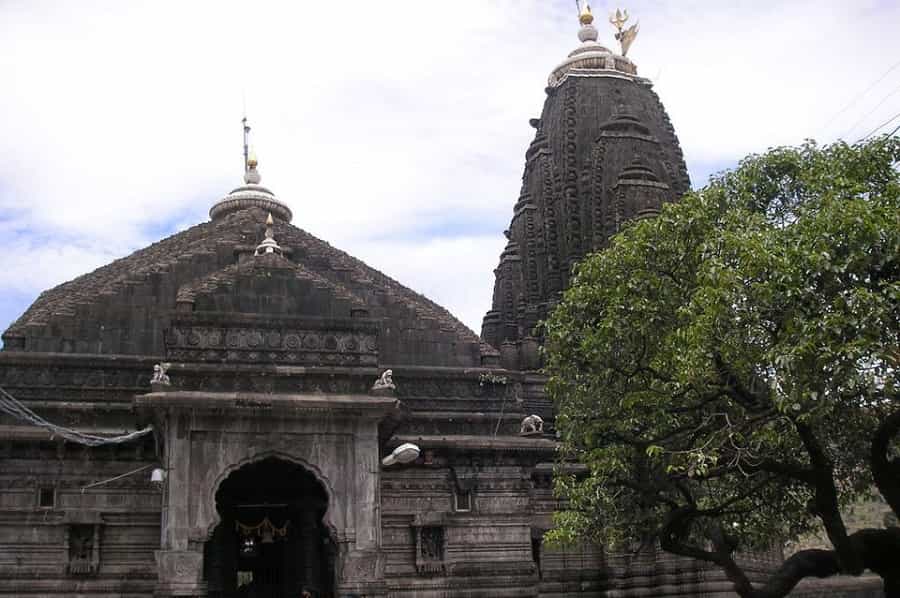
One of the twelve eminent Jyotirlinga temples in the country, Trimbakeshwar Jyotirlinga Temple is highly respected and adored by millions of pilgrims in India. At the source of the Godavari River, this temple was supposed to be built by Peshwa Balaji Baji Rao in the classic Hemadpanthi style. This Shiva temple is made of black stone. The lingam you see inside the temple depicts of three faces symbolizing Lord Vishnu, Brahma and Rudra garnered with three distinct golden crowns.
- Location: Trimbak, near Nasik, Maharashtra
- Nearby temples: Kedareshwar temple, Gorakhnath Gufa
- Best season to visit the temple: Oct-March
- How to reach: Gandhinagar Airport, Nashik (29 km); Nashik railway station
- Accommodation: Budget, standard, deluxe, and luxury hotels in Nashik
Baidyanath Temple
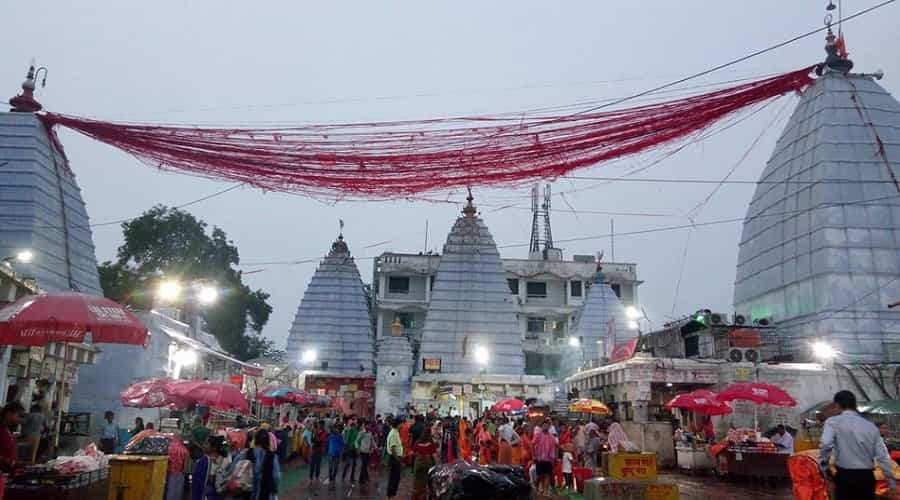
Baba Dham or Vaidyanatha Dham is considered as a place where demon king Ravana sacrificed his 9 heads to please lord, Shiva. In turn, Lord Shiva gave 9 heads back to Ravana after Ravana tried to take Mount Kailash to Sri Lanka with him. Like a Vaidya (doctor), lord Shiva joined the head and body of Ravana and this jyotirlinga became famous as Baidyanath Dham. This place is also famous as kamalingum for fulfilling the wishes of devotees.
- Location: Deogarh, Jharkhand
- Nearby temples: Naulakha Mandir, Basukinath Temple, Baiju Temple and Maa Shitala Temple
- Best season to visit the temple: Oct-March
- How to reach: Lok Nayak Jayaprakash Airport, Patna (272 Km), Baidyanathdham (BDME) and Deoghar (DGHR) railway stations; regular buses from Deoghar to Bokaro, Dhanbad, Ranchi, Jamshedpur
- Accommodation: Budget, standard, deluxe, and luxury hotels in Deogarh.
Nageshwar Temple
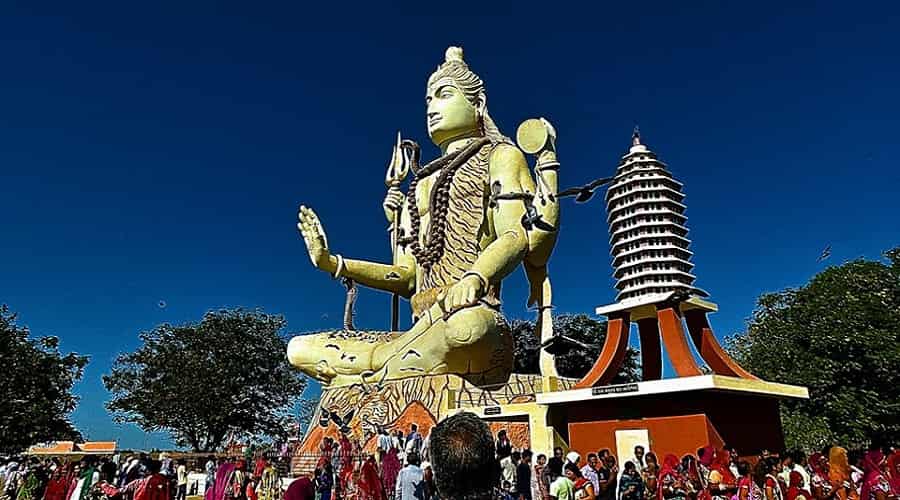
It is one of the 12 jyotirlingas of Lord Shiva on the coast of Saurashtra that is believed to be first ever jyotirlinga on earth. This holy Nageshwar Mahadeva temple has a beautiful 25 m tall Lord Shiva statue and devotees come to this great temple to become free from poison. It is also famous as a destination where Lord Shiva killed the devil named Daruka.
- Location: Dwarka, Jamnagar, Gujarat
- Nearby temples: Dwarkadhish Temple
- Best season to visit the temple: Oct-June
- How to reach: Jamnagar airport (137 km); regular bus services to Dwarka from Ahmadabad, Vadodara, Gandhinagar, Somnath, and Rajkot
- Accommodation: Budget, standard, deluxe, and luxury hotels in Jamnagar.
Ramanathaswamy Temple
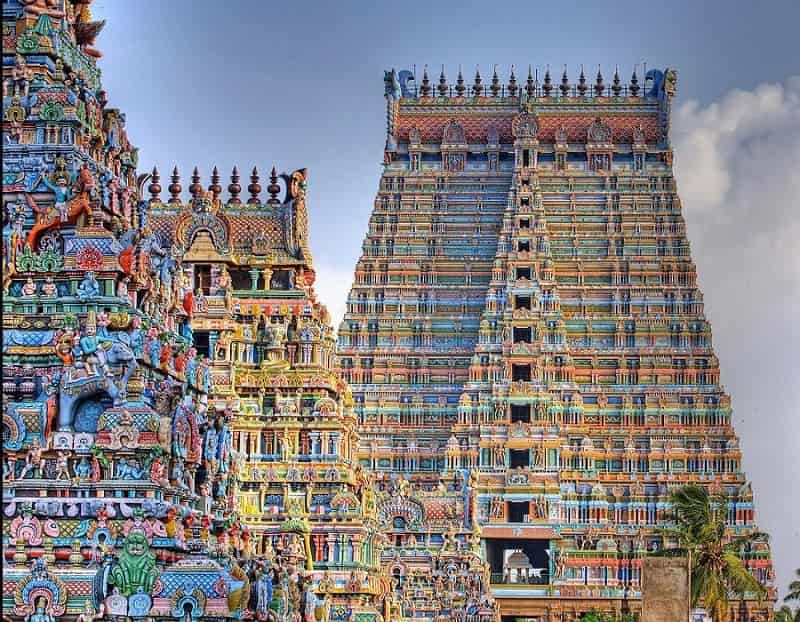
Existed on the island town Rameshwaram, Ramanathaswamy temple is a holy site for the followers of Lord Shiva, Vishnu, and Panchayatana. Famous for its architecture, corridors, and 36 theerthams, this Jyotirlinga is concerned with Ramayana when Lord Rama made a linga of sand and worshiped it to seek Lord Shiva’s blessings to defeat Ravana.
- Location: Rameswaram, Tamil Nadu
- Nearby temples: Dhanushkodi Temple, Kothandaramaswamy Temple,
- Best season to visit the temple: Oct-April
- How to reach: Madurai Airport (149 km); Rameshwaram railway station
- Accommodation: Budget, standard, deluxe, and luxury hotels in Rameswaram.
Grishneshwar Temple
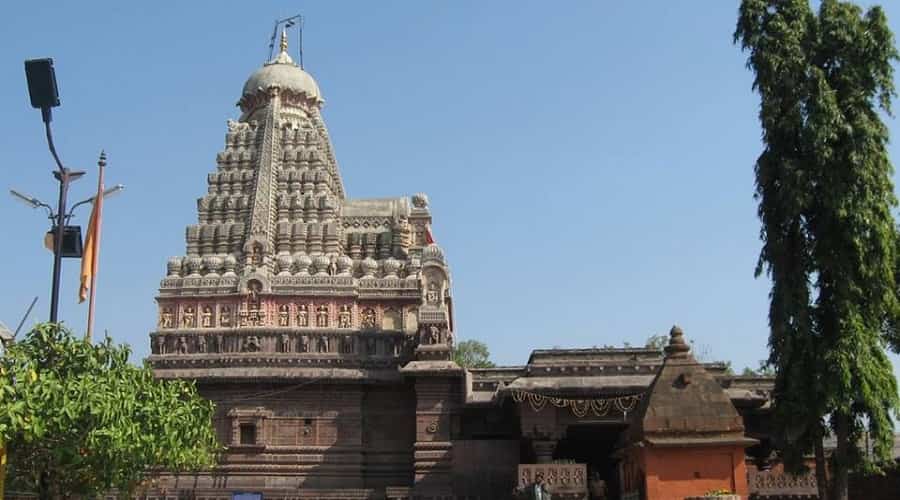
Built upon a bed of rocks by Maratha patron Ahilyabai Holkar, the Grishneshwar Jyotirlinga temple is one of the most preferred tourist destinations in India that is known for its architecture carved-statues, art works, and paintings. Kusumeshwar, Ghushmeshwar and Grushmeswara are other popular names of this holy shire for millions of Hindu pilgrims. This temple is associated with an interesting story of Shiva devotee Grushma we find in the Shiva Puran.
- Location: Ellora, Maharashtra
- Nearby attractions: Ellora caves
- Best season to visit the temple: Oct-April
- How to reach: Chikkalthana Airport (30 Km); Aurangabad Railway Station (30 Km)
- Accommodation: Budget, standard, deluxe, and luxury hotels in Ellora.
Pancha Bhoota Sthalas in South India
Jambukeshwar Temple
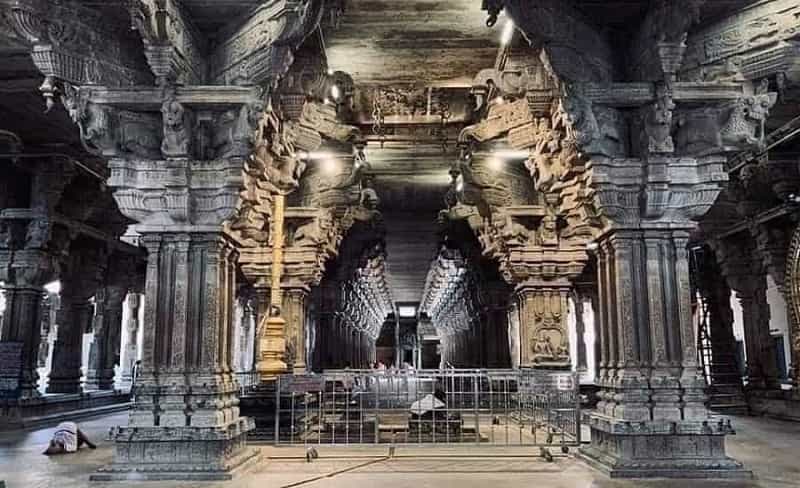
Sri Jambukeswarar Temple is a small temple but is beautiful one located in Tiruchirappalli. It is an oasis of quietness and serenity. It was built around the 10th century and still is in a very good shape. The temple is dedicated to Shiva and Parvati and a number of devotees come here to pay their tribute. There is a beautiful Shiva lingam immersed in water in front of the temple. There is a beautiful chamber lined with linga and statues of gods. Non-Hindus are not allowed to enter the sanctum. A nice place to visit and enjoy within 2 hours as it remain open all days of week at 5:30 AM – 1:00 PM and 3:00 PM – 8:30 PM.
-
- Address: Thiruvanaikaval Tiruchirappalli , Tamil Nadu, 620005
-
- Entry fee: No entry fee
- Timings: 5:30 am – 9:00 pm
- Visit duration: 45 minutes to 1 hour
- Best time to visit: November to March.
Arunachaleswar Temple
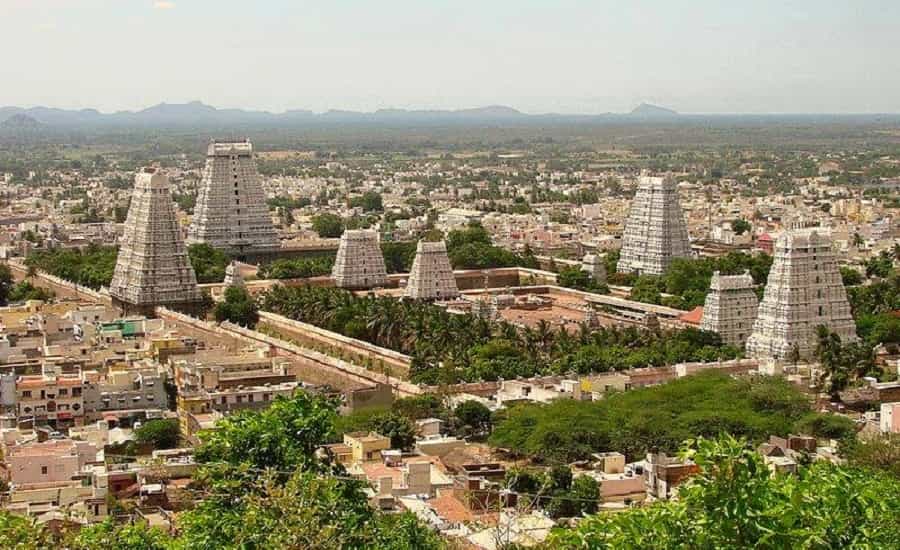
Arunachaleswar temple is famous as fire manifestation of Lord Shiva in Thiruvannamalai, Tamil Nadu. It is one of the largest temples in India dedicated to Annamalaiyar or Arunachaleswarar.
- Address: Pavazhakundur, Tiruvannamalai, Tamil Nadu 606601
- Entry fee: No entry fee
- Timings: 5:00 am to 9:30 pm
- Visit duration: 30 – 45 mins
- Best time to visit: October to March
Kalahasteeswara Temple
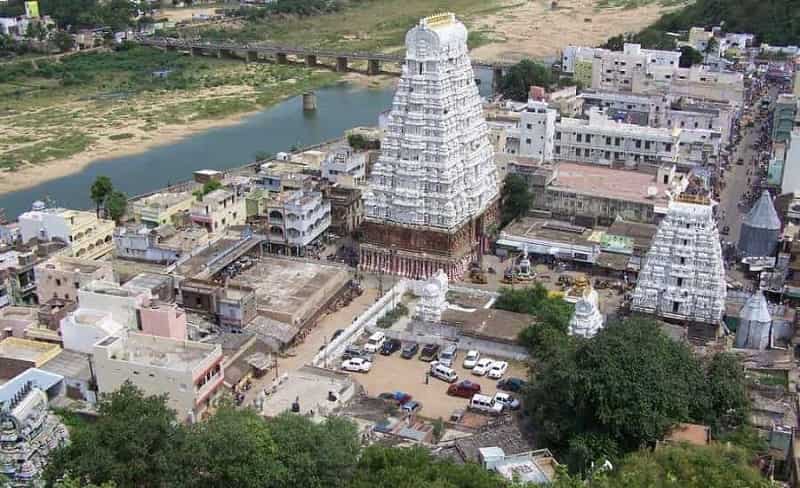
According to legend, the Sri Kalahasti Temple, located around thirty six kilometers away from Tirupati, is where Kannappa, one of the 63 Saivite Nayanars prepared to cover the blood flowing from the Linga with his eyes. However, Lord Shiva intervened by stopping and granting mukti to him. Constructed under the aegis of the Vijayanagara and Chola dynasty, the Sri Kalahasti Temple is one of the most revered and important Shiva temples in South India. The temple is dedicated to Lord Kalahasteeswara, an incarnation of Lord Shiva depicting the wind or Vayu as it is called. Well known for its Vayu Linga, the temple is also associated with two of the nine celestial bodies – Rahu and Ketu.
According to religious texts and interpretation, people who are under the influence of the Rahu Ketu or Sarpa Dosha, face numerous hardships and problems in their lives. Those wishing to rid themselves of this affliction, offer prayers here, especially on Sundays and Tuesdays, as these days are considered the best for the puja. The popularity of the temple can be gauged by the number of people from all over the world who come here to offer their prayers and ask for boons.
The Sri Kalahasti Temple is also known for its architecture, the highlights being the Mantapam (a hall) with a hundred pillars and the three Gopurams (doorways)
- Address: Srikalahasti, Andhra Pradesh 517644
- Entry fee: No Entry fee to enter the temple. 300 per person for Rahu Kethu Sarpa Dosha Nirvana puja (done in the outer courtyard) 750 per person for Rahu Kethu Sarpa Dosha Nirvana puja (done in the outer courtyard)
- Timings: All days of the week 5:00 AM – 12:00 PM4:00 PM – 9:00 PM
- Visit Duration: 1 hour
- Best time to visit: November to February
Ekambareswar Temple
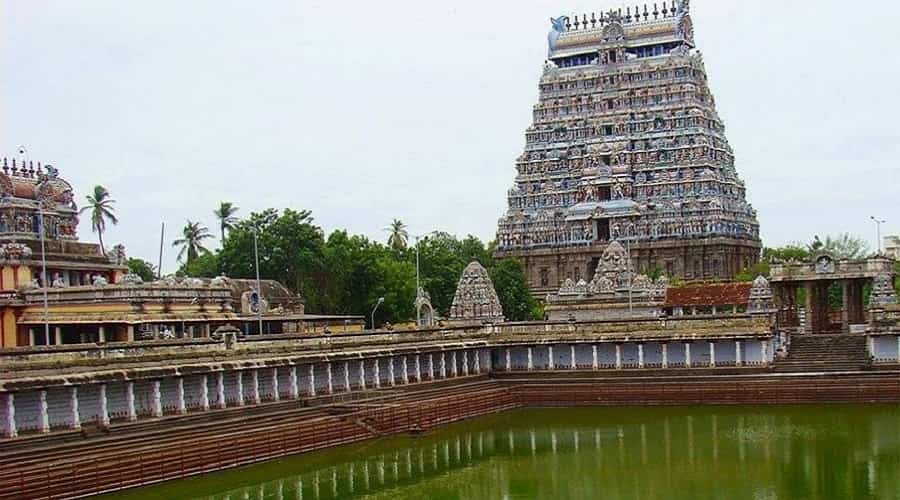
Built in the 9th century by Chola rulers, the Ekambareswar temple is famous as earth manifestation of Lord Shiva in Kanchipuram, Tamil Nadu.
- Address: Kilambi, Tamil Nadu 631502
- Entry fee: No entry fee
- Timings: 5:30 am to 8:30 pm
- Visit duration: 45 mins – 2 hours
- Best time to visit: During festivals
Nataraja Temple, Tamil Nadu
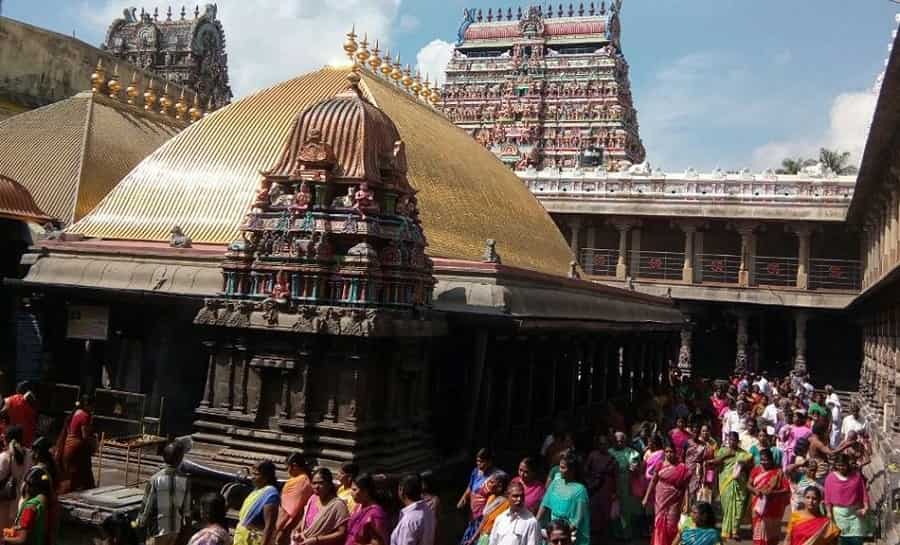
Built in the 12th and 13th centuries, the Nataraja temple is famous as sky manifestation of Lord Shiva in Chidambaram, Cuddalore District, in Tamil Nadu.
- Address: Chidambaram, Tamil Nadu 608001
- Entry fee: No entry fee
- Timings: 6:00 am to 9:00 pm
- Visit duration: 1 – 2 hrs
- Best time to visit: October to March
Some other Popular Temples of Lord Shiva
Neelkanth Mahadev Temple, Uttarakhand
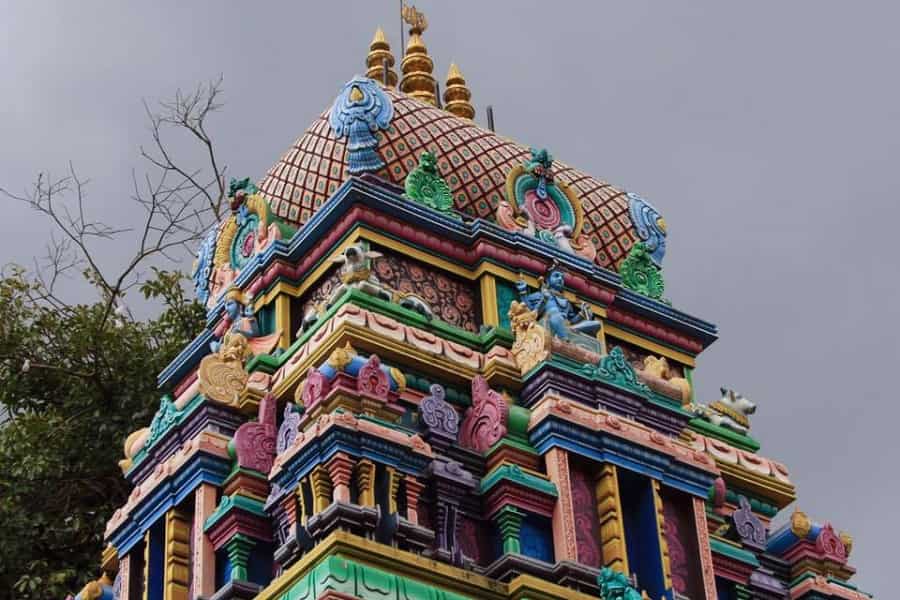
Close to the Nar-Narayan Hill Range and the convergence of Pankaja River and Madhumati River, there is a holy shrine dedicated to Lord Shiva called Neelkanth Mahadev Temple. This temple is famous for Kanwar Yatra in the month of Shravan. At this shrine, people worship Lord Shiva Neelkanth, the God with Blue Throat. This one of the most famous temples dedicated to Lord Shiva has a mythological significance when Lord Shiva’s throat turned blue after almighty consumed all the venom came out of Samudra Manthan. The temple also has a natural spring where Shiva devotees can take a holy bath before entering the temple. At this ancient temple, Lord Shiva is worshiped as the presiding deity in a phallic form a ‘Shiv Lingam’.
- Location: 32 km from Rishikesh in the Pauri Garhwal district of Uttarakhand
- Nearby temples: Ram Jhula, Lakshman Jhula, Triveni Ghat, Bharat Mandir, and Trimbakeshwar Temple
- Best season to visit the temple: Throughout the year
- How to reach: Jolly Grant airport; Rishikesh Railway Station; Regular bus services from Delhi, Haridwar, Dehradun
- Accommodation: Budget, standard, deluxe, and luxury hotels in Rishikesh
Amarnath Yatra, Jammu & Kashmir
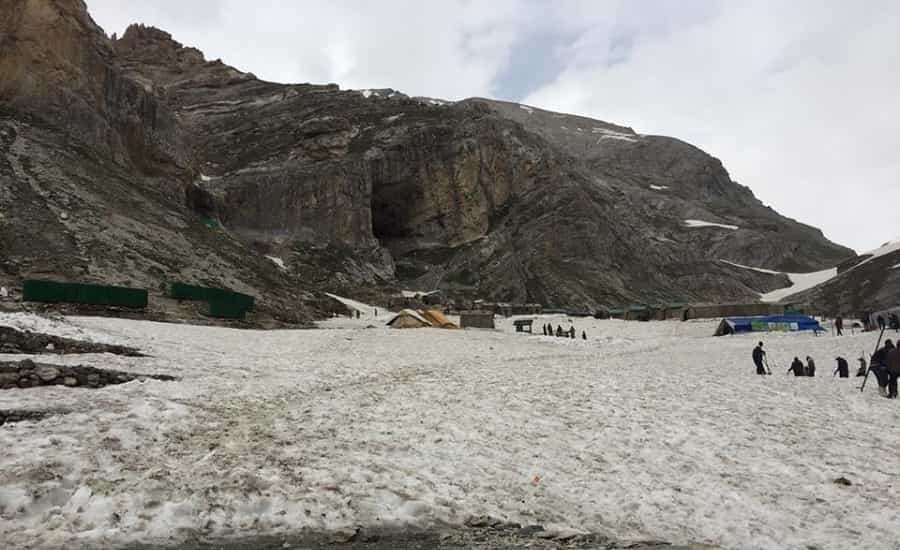
As the moon waxes and wanes, the size of ice Shiva-linga changes its size in the Amarnath Temple or Cave existed at 55 Km from Kokernag and 141 km from Srinagar. This cave is usually remained closed throughout the year, except the summers when it is opened for devotees only for a few days. At this holy and most famous Lord Shiva temple in India, you will find a naturally occurring ice Shivlinga. Amarnath temple, surrounded by thick snow around, is an important pilgrimage destination for the followers of Lord Shiva. Interestingly, Shiva Linga of this temple is a stalagmite. When water drops dripped from the roof on the floor, it gets a solid structure on the floor.
Amarnath Yatra is not open for all. You have to prove your ability to take part in the holy Yatra. Recently, the yatra was in news owing to a terrorist attack on pilgrims traveling in a bus.
- Location: Baltal Amarnath Trek, Forest Block, Anantnag, Pahalgam, Jammu and Kashmir
- Best season to visit the temple: May-September
- How to reach: Srinagar International Airport (72 km); Jammu Railway station (178 km); Take a helicopter from Srinagar and land at Panjtarni (2 km)
Mukteswara Temple, Odisha
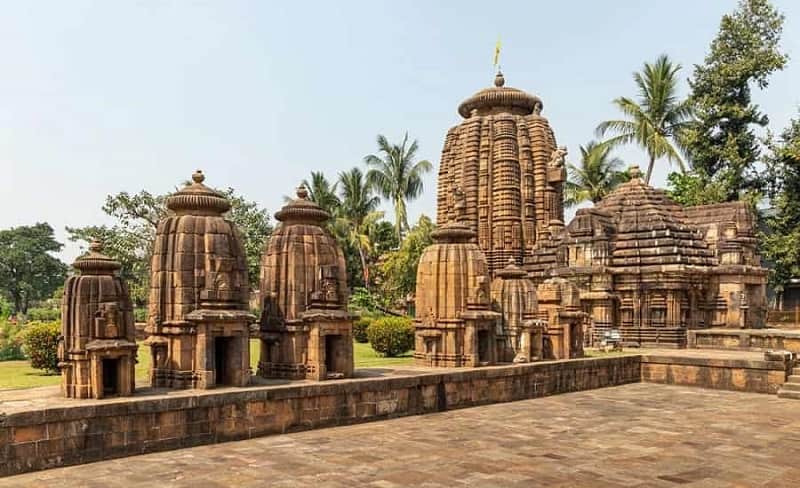
The Mukteshwar temple is considered to be one of the most decorated temples of Bhubaneswar. This dedicated to Lord Shiva and is very old as its history goes back to 970 CE. The Temple is 34 feet high and is believed to be the smallest and most compact temples located in Bhubaneswar. As the name suggests the name of the temple means” Lord who gives freedom through the practice of yoga”.
Upon visiting the temple you will notice the various images of people doing yoga in different poses, also images depicting the folk tales as well as the stories from the Panchatantra tales and Jain saints. The porch has been decorated with beautiful carvings of lotus and lion heads. There are many carvings of several gods, goddesses, many birds, animals and religious scenes.
Siddheshwar Mandir, is also located in the same compound, however this is located in the North-western direction of the Mukteshwar temple. This temple has a statue of the elephant god, Lord Ganesha in a standing position. There are seven mouldings, and the walls are decorated with “Pidhu” and “Khakra” mundis.
On the other side of the road is the Kedargouri Mandir. This is one of the eight Astasambhu temples. Like the Mukteshwar temple, this is also dedicated to Lord Shiva. Shiva is known as “Kedareshwar”. The temple faces the south direction and the deity is made up of sandstone. This is believed to be the oldest temples of Bhubaneswar, although this has been rebuilt quite a few number of times.
- Address: Kedar Gouri Ln, Gouri Nagar, Old Town, Bhubaneswar
- Entry fee: No entry fee
- Timings: 6:30 am – 7:30 pm
- Visit duration: 1 hour
- Best time to visit: October to March
Lord Shiva Temples in Indian States
Apart from 12 jyotirlingas and Pancha Bhoota Sthalam in South India, there are thousands of big and small and new and old temples in India, dedicated to the supreme destroyers. Find out the top most temples in the following Indian states and pay your respect to the ultimate ruler of the world.
Lord Shiva Temples in West Bengal
Malleswara Temple
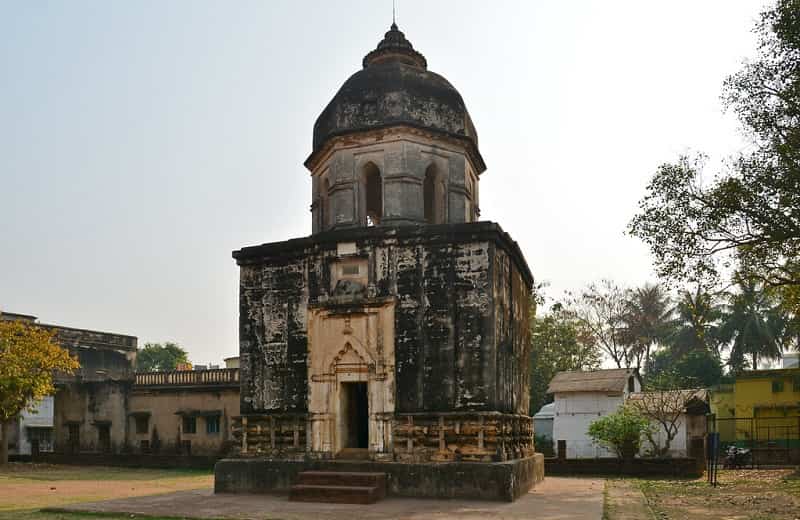
The Malleswara temple was built by king Raghunath singh in the year 1622 A.D and is situated in Bishnupur. This temple was dedicated to Shiva, Its architecture is different to any other temple in the area and is described as Rekha Deul.
| Address | Bankura district, Bishnupur, West Bengal 722122 |
| Timings | All days of the week 6:00 AM – 9:00 PM |
| Visit duration | 1 hour |
| Entry fee | Free |
Lord Shiva Temples in Goa
- Mahadev Temple, Tambdi Surla
- Mangueshi Temple, Mangeshi village
- Nagueshi, Nageshi
- Saptakoteshwar Temple, Narve
- Vimleshwar Temple, Rivona
Lord Shiva Temples in Assam
- Kedareswara Temple, Hajo, Assam
- Umananda Temple, wonderful “Peacock Island”
- Maha Bhairav Temple
Lord Shiva Temples in Maharastra
Elephanta Caves, Mumbai

The Elephanta caves are a group of ancient caves depicting beautiful sculptures and carvings and have been granted UNESCO world heritage site cover. The caves start with a huge entrance hall in which there are tall pillars on either side and there is a big Mahesamurti statue that is the center of attraction. This statue is a 3 headed figurine of Lord Shiva and is the cynosure of all eyes here. Here the other forms of Shiva such a Nataraja and Ardhanarishvara can also be seen in the form of sculptures.
The cave complex is made completely of natural stone and it lies in the sea which takes about an hour to reach via a ferry. Once you reach the island you would need to climb about 120 steps to reach the cave complex. For those who cannot climb on their own or have some difficulty there is a Palanquin service available which they can make use of.
| Address | Gharapuri, Maharashtra, 400094 |
| Timings | 9 am to 5 pm |
| Visit duration | 4-5 hours |
| Entry fee | Rs.40 per person SAARC and BIMSTEC countries Rs.600 per person for foreigners. |
- Babulnath Shiva Temple, Mumbai
- Vaijnath Shiva Temple, Parali
- Kopeshwar Shiva Temple, Kolhapur
- Aundha Nagnath Temple, Hingoli
- Kailash Shiva Temple, Ellora
- Shiv Mandir, Maharashtra, Vangaon
- Walkeshwar Temple, Mumbai
- Ambarnath Shiva Mandir, Ambarnath
Lord Shiva Temples in Gujarat
- Bavka Shiva Temple, Chandwada Village, around 14 km from Dahod
- Koteshwar Temple, 165 km from Bhuj, Kachchh District
- Shiva Temple at Polo, 70 km from Idar, Sabarkantha District
- Kumbeshwar Mahadev, Ambaji, Banaskantha District
- Galteshwar Temple, 15 km from Dakor, Kheda district
- Bhavnath Mahadev, Mount Girnar, Junagadh district
- Malika Arjun Temple, Chikhli, Navsari district
- Utkanteshwar Mahadev, Kapadvanj, Kheda district
- Nishkalank Mahadev Temple in Koliyak, Bhavnagar, Gujarat (in the Arabian Sea)
Lord Shiva Temples in Karnataka
Badami Cave Temples
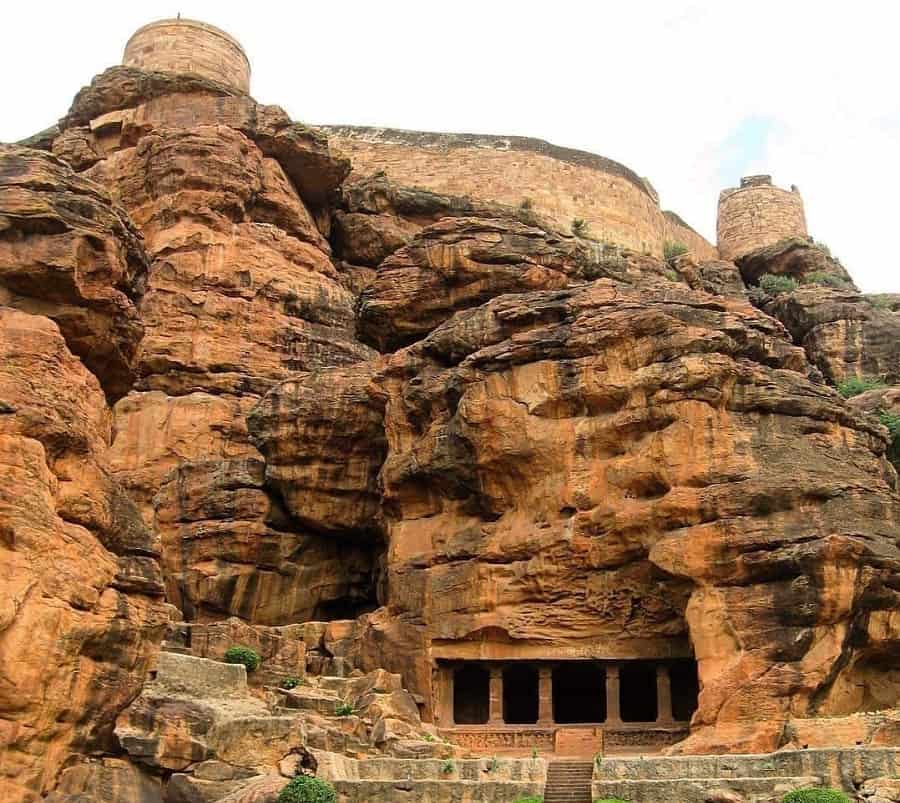
Beautiful Cave Temples are the major attraction in Badami. You can consider hiring a guide who is not pushy and well informed. They will ask for Rs. 200 for a tour of the caves, or Rs. 300 to guide you through the whole site. Be watchful of mischievous monkeys. Situated just above the complex’s entrance is the cave one, dedicated to Shiva. It is estimated to be carved in the latter half of the 6th century and is known as the oldest of the four caves. There is an enticing image of Nataraja striking 81 dance poses on the wall to the right of the porch. On the right of the porch lies a huge structure of Ardhanarishvara which has its right half featuring figure of Shiva, while the left half displays the captivating features of his wife Parvati. On the wall opposite it rests the figure of Harihara; half Vishnu and half Shiva.
The cave two is dedicated to Vishnu and comparatively simpler in design. The caves one and three display the images of pot-bellied dwarfs striking different poses, which are carved on the front edge of the platform. There are four pillars supporting the verandah. The tops of these pillars are carved with a yali-shaped (mythical lion creature) bracket. A bull-headed figure of Varaha is sculptured on the left wall of the porch. Varaha is an incarnation of Vishnu, adopted by the Chalukya Empire as their emblem. The admission to the cave temples costs Rs. 5 and Rs. 100 to an Indian and foreigner respectively. You can visit it from dawn through dusk.
- Address: Badami, Karnataka 587201
- Deity: Lord Shiva
- Timings: 9:00 am – 5:30 pm
- Visit Duration: 3-5 hours
- Entry fee: 30 INR for Indians, 500 INR for Foreigners
Gokarna
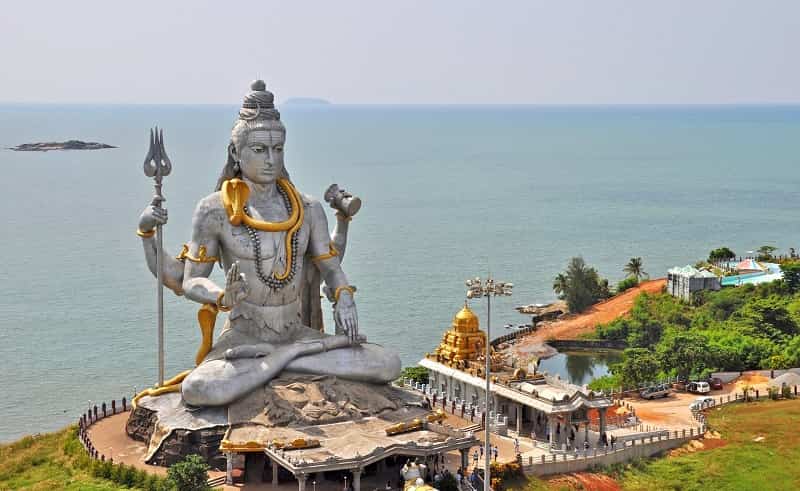
A tiny temple town situated on the western coast of the state of Karnataka, Gokarna is presided by Lord Shiva, the popular deity of Hindu faith. Also called Mahabhaleshwara, this place of high religious worth, contains the original image of Shiva’s lingam. Boasting of a host of other smaller shrines as well, Gokarna is located near Kumta and Ankola, on Highway 17. Ranking high on the list of Hindu pilgrimage centers in the country, Gokarna lies in the precincts of an erstwhile pristine unspoiled beach located near the estuary of River Aghanashini. The area is flush with colorful tropical fruits, beautiful palm trees and other flower trees. In recent times, the character of the town has changed to a large extent–with people reaching this venue for reasons more than just prayers and offering of worship.
Gokarna, once unspoiled and of rustic nature, was a natural getaway for younger western tourists and locals (almost a decade ago). However, this beach destination is now thriving with a host of restaurants and resorts of high value. A must visit for tourists of all ages and from all walks of life.
| Address | Koti Teertha Road, Kotiteertha, Gokarna, Uttara Kannada, 581326 |
| Timings | 6 am to 12 pm. 5 pm to 8 pm |
| Visit duration | 1-2 hours |
| Entry fee | Free |
| Festivals | Maha Shivratri |
- Dharmasthala Manjunatha Temple, Dakshina Kannada, Dharmasthala
- Kadri Manjunath Temple, Dakshina Kannada
- Kotilingeshwara, Ghattakamadenahalli, Kolar
- Murudeshwara, Bhatkal Taluk, Uttara Kannada (Associated with Ravana)
- Srikanteshwara Temple, Nanjangud
Lord Shiva Temples in Uttar Pradesh
- Balkeshwar Mahadev Mandir, Kamala Nagar, Agra
- Lodheshwar Mahadev Mandir, Barabanki
- Pura Mahadev temple (built by Sage Parashurama) in Baghpat
- Waneshwar Mahadev Temple (built by Daityaraj Wanasur), Banipara Jinai, Kanpur
Lord Shiva Temples In Madhya Pradesh
- Bhojeshwar Temple (Built by Bhoja kings), Bhojpur
- Kal Bhairav temple (Built king named Bhadrasen) Ujjain
- Pashupatinath temple, Mandsaur
Lord Shiva Temples in Tamil Nadu
Sarabhumurti Temple (Kampahareswarar)
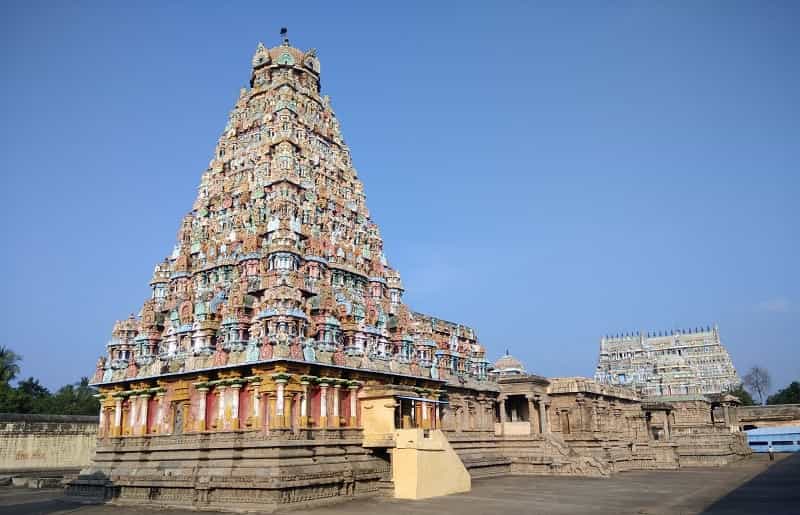
Constructed under the aegis of King Kulottunga Chola III in celebration of a victory in war, the Sarabhamurti Temple is very similar to the Airavatesvara Temple at Darasuram with a similar vimanam and a mandapam shaped like a chariot. Sculpted panels lining the walls of the temple depict scenes from the epic Ramayana. Also known as the Kampahareswarar Temple, it is dedicated to an incarnation of lord Shiva depicted as part god, part animal and part bird. According to legends, Lord Shiva took on this form to calm the fury of Narasimha, an incarnation of lord Vishnu.
Followers and devotees come to the temple to gain relief from debts, litigations and to ward off the effects of black magic. Located in Tribhuvanam, the town is well known for its silk weaving with the market full of shops selling silk saris and cloth.
- Address: Tribhuvanam, kumbakonam Thanjavur , Tamil Nadu
- Timings: All days of the week 6:00 AM – 12:00 PM 4:00 – 9:00 PM
- Visit Duration: 1 to 2 hours
Airavateshwara Temple
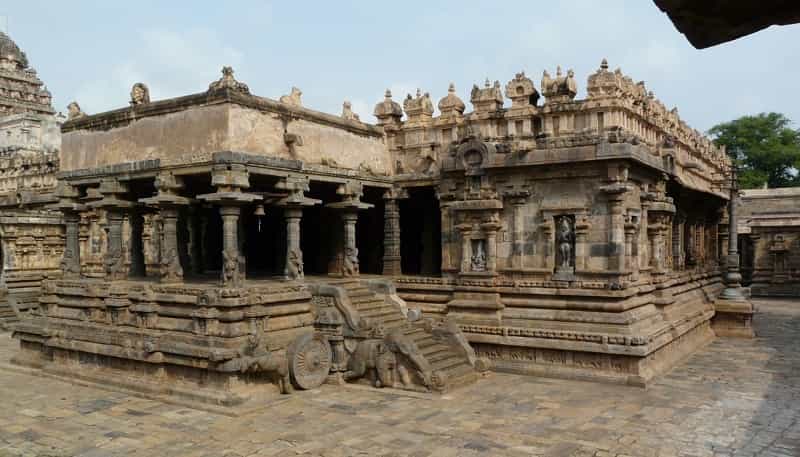
Constructed in the 12th century under the aegis of King Raja Raja II, the Airavateeswara Temple was further improved upon by subsequent Nayak kings. Although under the patronage of the Thanjavur Royal family, the temple is maintained by the Archaeological Survey of India as it is a declared UNESCO World Heritage Site. There are two more UNESCO World Heritage Sites in the area – the Thanjavur’s Brihadeshwara Temple and Gangaikondacholapuram.
An amazing display of architecture and sculpture finesse of that era, the temple requires a good couple of hours to really see and appreciate its beauty. The finesse and intricacies in the stone work and the detailing in the sculptures leaves one spell bound. The pillars of the main hall are sculptured depicting scenes from the daily lives of the people of the 12th century and also scenes from the Puranas. The Vimanam or the hall of the main sanctum is in the shape of a chariot with wheels on one side and elephants and horses supporting it on the other. The most interesting part though is the steps leading to the sacrificial stone (bali peetham). Made of stone, the steps produce different musical scales if another stone is rolled down on them. Dedicated to Lord Shiva, the outer walls of the temple have niches in them that hold idols of other deities. Located at Darasuram, the road leading to this place is lined with workshops of present day stone craftsmen who still carve and sculpt statues of Gods along with those of animals and birds.
| Address | Gurunathan Pillai Colony, Darasuram, Kumbakonam 612702 Thanjavur, Tamil Nadu |
| Entry Fee | No entry fee |
| Timings | All days of the week 5:00 AM – 12:00 PM 4:00 PM – 9:00 PM |
| Visit Duration | 1 to 2 hours |
- Natarajar Temple in Chidambaram
- Meenakshi Sundareswarar Temple in Madurai
- Nellaiappar Temple in Tirunelveli
- Sri Vadaranyeswarar Temple in Thiruvalangadu
- Kutraleeswar Temple in Kutralam
Lord Shiva Temples in Kerala
- Bhavaneeswara Temple, Palluruthy
- Elannummel Shiva temple
- Mahadeva Temple, Chengannur
- Mahadeva Temple, Vaikom
- Rajarajeshwara Temple, Taliparamba
- Thiruvairanikulam Temple
- Vadakkunnathan Temple, Thrissur
Lord Shiva Temples in Odisha
- Ajaikapada Bhairava Temple in Jagatsinghpur
- Astasambhu Siva Temples (8 Hindu temples) in Bhubaneswar
- Gupteswar Cave temple, Jeypore
- Lingaraj Temple, Bhubaneswar
- The Leaning Temple of Huma, Sambalpur
Lord Shiva Temples in Uttarakhand
- Baghnath in Bageshwar and Binsar Mahadev Temple in Almora
- Budha Kedar Temple in Tehri Garhwal
- Gauri Shankar Temple and Bilkeshwar Mahadev Temple in Haridwar
- Gopinath Temple and Rudranath Temple in Chamoli
- Koteshwar Mahadev Temple, Madhyamaheshwar Temple, Omkareshwar Temple, Tungnath Temple and Agasteshwar Mahadev in Rrudraprayag
- Lakha Mandal Temple and Tapkeshwar Temple in Dehradun
- Patal Bhuvaneshwar Temple (home to 33 crore gods and goddesses) in Pithoragarh district
- Vishwanath Temple and Kaleshwar Mandir in Uttarkashi
Lord Shiva Temples In Andhra Pradesh And Telangana
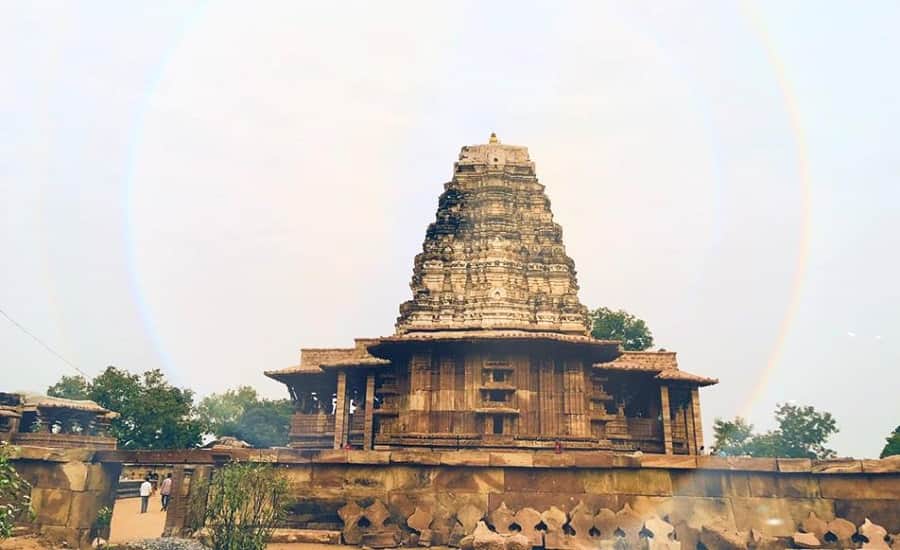
Located at a distance of 77Kms. from Warangal. The temple may aptly be described as the “Brightest star in the galaxy of medieval temples of the Deccan”. Constructed in 1234 AD. by Racharla Rudra, a subordinate of king Ganapathi, it has also subsidiary shrines on its Northern ends. The temple is similar in style and workmanship to the Thousand Pillar temple but is more ornamental.
The pillars, the brackets, the ceilings and the walls are full of ornamentation carrying figures of Gods, Goddesses, Warriors, Musicians and dancers in different poses, depicting scenes of Ramayana and Mahabharata. The polish, the fine and tomy, the life and the rhythm of these figures make them look life-like. The spire is built of light spongy bricks which float on water.
| Address | Nandi Mandapam, RAMAPPA, Mulugu, Telangana 506345 |
| Timings | All days of the week 6:00 AM – 6:00 PM |
| Visit duration | 1 to 2 hours |
| Entry fee | Free |
- Amaralingeswara Swamy temple in Amaravathi
- Bhimeswara Swamy Temple at Draksharamam
- Komrelly Mallanna Temple in Komuravelli Village, Cheriyal Mandal, Warangal
- Ksheera Ramalingeswara Swamy temple in Palakollu
- Kumara Bhimeswara Swamy temple in Samalkota
- Mahanandishwara Temple in the district of Kurnool
- Raja Rajeswara temple in Vemulawada
- Someswara Swamy temple in Bhimavaram
- Sri Kalahasti near Tirupati
- Sri Raja Rajeswara Swamy Temple at Vemulawada
- Srikalahasteeswara Temple in the town of Srikalahasti
- Thousand Pillars Temple in Hanamkonda, Warangal
Lord Shiva Temples Around The World
Like India, there are lots of Lord Shiva temples in all parts of the world. All these temples are popular and have been established by Hindus living in foreign countries, after having permission from the concerned authorities.
- 9th century old Prambanan Temple in Java, Indonesia
- Arulmigu Sri Raja Kaliamman Temple in Johor Baru, Malaysia
- Katasraj Temple (where Pandavas took refuge during their exile) in Chakwal, Pakistan
- Mukti Gupteshwar Temple in Minto, Sydney, Australia
- Munneswaram Temple (where Lord Ram prayed to Lord Shiva) in Munneswaram, Sri Lanka
- Pashupatinath Temple (Built by Prachanda Deva) in Kathmandu, Nepal
- Shiva Hindu Temple in Zuidoost, Amsterdam
- Shiva Temple in Muscat, Oman
- Shiva Temple in Zurich, Switzerland
- Shiva Vishnu Temple in Livermore, California
- Shiva Vishnu Temple in Melbourne, Australia
- Shivan Koil (Shiva Temple) in Lenasia, Johannesburg
- The Sivan Kovil in Lewisham, London
Although there are numerous Lord Shiva temples all over the world, including India, yet all mentioned-above temples have a historical and mythological reference. That is why they are considered as most important destinations for all Hindu in a candid manner.
